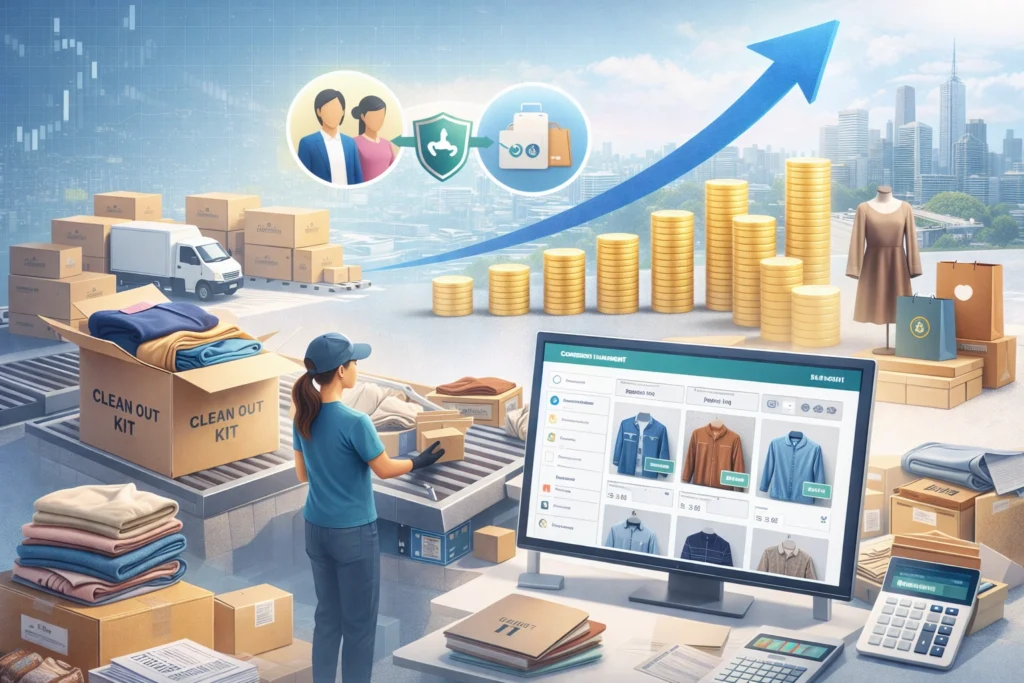The grocery delivery industry has experienced unprecedented growth in recent years, with platforms like Instacart leading the charge. As consumers increasingly turn to on-demand services for convenience, grocery businesses must adapt to meet these new demands. Instacart, with its user-friendly interface and advanced features, has set a benchmark for the industry.
In this guide, we will delve into the Ideas for Organic Grocery Delivery Business Startups and explore how grocery stores can leverage these functionalities to enhance customer satisfaction, streamline operations, and drive revenue growth.The rise of the on-demand grocery delivery model is not just a trend—it’s a fundamental shift in the retail landscape. Consumers now expect faster service, greater convenience, and seamless digital interactions.
For grocery businesses looking to stay competitive, understanding and implementing features like those in Instacart is critical.By the end of this guide, you’ll have a comprehensive understanding of the key Instacart clone app features that are essential for creating a successful grocery delivery app or improving an existing one. These features can help grocery businesses optimize their operations, boost customer engagement, and offer a seamless shopping experience.In addition, we’ll touch on future trends that will shape the grocery delivery space, along with development considerations, costs, and the technologies required to build an Instacart-like platform. Whether you’re a small grocery store or a large supermarket chain, incorporating these features will be a game-changer for your business.
Why Instacart is a Leader in Grocery Delivery
Instacart has emerged as a dominant player in the grocery delivery industry, offering a comprehensive solution for both consumers and businesses. Its success can be attributed to several key factors:
- Convenience: Instacart provides a seamless platform that allows customers to order groceries from local stores, ensuring quick delivery right to their doorsteps. This level of convenience appeals to the modern consumer who prioritizes speed and ease.
- Widespread Store Partnerships: By partnering with major grocery chains and local supermarkets, Instacart can offer customers a wide range of products, providing more variety and availability than many standalone grocery delivery apps.
- Scalable Technology: Instacart’s platform is designed to handle high volumes of orders efficiently, ensuring smooth operations even during peak times such as holidays or emergencies. For grocery businesses, this scalable technology reduces friction in delivery management.
- Comprehensive User Experience: Instacart’s interface is designed to enhance the user journey, from easy product search to real-time delivery tracking, contributing to a frictionless shopping experience. For grocery businesses, adopting such a streamlined process helps retain customers and build trust.
- Advanced Data Analytics: Instacart leverages data to predict customer behavior, optimize delivery routes, and manage inventory. This not only reduces costs but also ensures that businesses remain efficient, offering customers what they need when they need it.
Why This Matters for Grocery Businesses:
Instacart’s dominance highlights the importance of integrating features that cater to customer demands for fast, reliable, and diverse grocery delivery services. For businesses aiming to compete or complement Instacart, understanding and implementing these essential features can be the key to capturing a loyal customer base in the competitive grocery delivery market.
Essential Features of the Instacart App for Grocery Delivery
| Feature | Benefit for Businesses |
|---|---|
| User-Friendly Interface | Enhances user experience, increases customer retention. |
| Real-Time Inventory Management | Reduces out-of-stock issues, ensures operational efficiency. |
| Multiple Payment Options | Increases conversions by offering diverse payment methods. |
| Delivery Scheduling & Tracking | Provides convenience and transparency to customers. |
| Push Notifications and Offers | Improves engagement and promotes repeat purchases. |
To build a successful grocery delivery app like Instacart, businesses must incorporate features that enhance the user experience and streamline operational efficiency. Here are the key Instacart app features that make it an industry leader:
1. User-Friendly Interface
The app’s simple and intuitive interface allows users to easily navigate through different sections, select items, and check out. For grocery businesses, offering a user-friendly experience is critical to retaining customers and ensuring repeat orders.
Key Benefits:
- Easy Navigation: Reduces friction in the customer journey, leading to higher conversions.
- Seamless Checkout: A smooth, streamlined checkout process that ensures users complete their orders without hassle.
2. Product Search and Categorization
Instacart offers robust product search capabilities, allowing users to easily find items through filters such as brand, price, and nutritional information. Organizing products into clear categories helps customers find what they need quickly and efficiently.
Key Benefits:
- Faster Search: Helps customers find products quickly, enhancing their shopping experience.
- Advanced Filters: Allows for more refined searches, catering to customer preferences like dietary restrictions or favorite brands.
3. Real-Time Inventory Management
One of Instacart’s strengths is its real-time inventory updates. By integrating with local store databases, the app provides customers with accurate availability information, minimizing out-of-stock frustrations.
Key Benefits:
- Accurate Inventory: Ensures that customers see exactly what’s available in real time.
- Reduced Cart Abandonment: Customers are less likely to abandon their carts due to unexpected out-of-stock items.
4. Multiple Payment Options
Instacart offers users various payment methods, including credit cards, digital wallets, and even contactless payments. This flexibility caters to a wide range of customer preferences.
Key Benefits:
- Increased Convenience: Customers can choose their preferred payment method.
- Higher Conversion Rates: Offering multiple payment options reduces friction at checkout, increasing completed transactions.
5. Delivery Scheduling & Tracking
Instacart allows customers to schedule deliveries at their convenience and track them in real time. This feature provides transparency and gives customers control over their deliveries, improving overall satisfaction.
Key Benefits:
- Convenient Scheduling: Allows users to choose delivery times that fit their schedules.
- Real-Time Tracking: Provides live updates on order status, increasing transparency and trust.
6. Integration with Local Stores
Instacart’s ability to integrate with a wide variety of local grocery stores is one of its standout features. This not only gives customers more choices but also helps local businesses reach a broader audience.
Key Benefits:
- Expanded Reach for Stores: Allows local stores to tap into the online market.
- More Choices for Consumers: Increases product variety, enhancing customer satisfaction.
7. Push Notifications and Offers
Instacart keeps users engaged through timely push notifications, including order updates, special offers, and personalized promotions. This feature not only improves communication but also encourages users to return to the app.
Key Benefits:
- Real-Time Updates: Keeps customers informed about their order status.
- Personalized Promotions: Drives engagement and increases order frequency through tailored offers.
Each of these features plays a vital role in ensuring smooth operations for grocery delivery businesses and a satisfying experience for customers. By integrating similar functionalities into their apps, grocery businesses can greatly enhance both operational efficiency and customer loyalty.

Additional Features Enhancing Grocery Business Solutions
While Instacart excels at providing essential features, it also includes additional functionalities that further enhance the user experience and operational efficiency of grocery delivery businesses. These features can help improve customer engagement, loyalty, and overall satisfaction.
1. Customer Reviews and Ratings
Instacart allows customers to leave reviews and rate products, which helps other users make informed decisions. This feature also provides valuable feedback to grocery businesses, helping them improve product offerings and service quality.
Key Benefits:
- Improved Customer Trust: Positive reviews and high ratings boost credibility.
- Actionable Feedback: Businesses can use reviews to improve product selection and customer service.
2. Loyalty Programs and Discounts
To encourage repeat orders, Instacart integrates loyalty programs and promotional discounts. This keeps customers engaged and incentivizes them to continue using the platform.
Key Benefits:
- Customer Retention: Loyalty programs help build long-term relationships with customers.
- Increased Sales: Discounts and special offers drive more frequent orders.
3. Customer Support and Feedback Channels
Instacart offers robust customer support through in-app messaging, chatbots, and phone support, ensuring that users can resolve issues quickly. Feedback channels provide insights into customer satisfaction and areas for improvement.
Key Benefits:
- Real-Time Issue Resolution: Quick customer support improves satisfaction.
- Continuous Improvement: Feedback helps businesses make data-driven decisions to optimize services.
By incorporating these additional features, grocery businesses can elevate their grocery delivery management systems and provide an enriched customer experience, leading to higher customer loyalty and growth.
Looking to build the next big grocery delivery app?
From real-time inventory updates to instant checkout,
we develop custom solutions tailored to your needs.
Tech Stack and Development Considerations
Building an app like Instacart requires a robust technology stack to ensure scalability, security, and a seamless user experience. Here are some of the key components involved in developing a grocery delivery app:
1. Front-End Development
- Technology: Typically involves frameworks like React Native or Flutter for a seamless, cross-platform mobile experience.
- Goal: Ensure the app is responsive, fast, and user-friendly on both iOS and Android devices.
2. Back-End Development
- Technology: Node.js, Ruby on Rails, or Python/Django are common choices for building the back-end infrastructure. They ensure reliable data management, secure transactions, and fast processing.
- Database: Databases like MySQL, PostgreSQL, or MongoDB manage user data, orders, and inventory.
3. Real-Time Updates and API Integration
- Real-Time Features: Technologies like Socket.io or Firebase are used for real-time features like delivery tracking and inventory management.
- APIs: To integrate with local stores, payment gateways (like Stripe or PayPal), and geolocation services for delivery tracking.
4. Security
- SSL Encryption: Ensures secure data transmission for payments and personal data.
- Authentication: Implement features like two-factor authentication (2FA) to protect user accounts.
5. Cloud Infrastructure
- Hosting: Use cloud services like AWS, Google Cloud, or Microsoft Azure for scalability, ensuring the app can handle large traffic volumes during peak times.
Understanding the tech stack behind an app like Instacart ensures a smooth development process and guarantees that the app performs well under different conditions. Choosing the right technology can significantly impact the app’s success, particularly for growing grocery delivery businesses.
Cost and Time Estimations
Developing a grocery delivery app like Instacart involves a number of factors that influence both the cost and the time it takes to build. Here’s a breakdown:
1. Cost Estimations
- App Development Costs: Building a basic grocery delivery app can range from $30,000 to $100,000 depending on the complexity, features, and geographic location of the development team.
- Additional Costs: Expenses for API integrations (such as payment gateways, map services), server maintenance, cloud storage, and data security must be factored in.
2. Time Frame for Development
- Basic App: A basic Instacart-like app may take 4 to 6 months to develop.
- Advanced Features: Adding complex features like real-time tracking, advanced analytics, and third-party integrations can extend development time to 9-12 months or longer.
| App Feature | Estimated Cost | Estimated Time |
|---|---|---|
| Basic Grocery Delivery App | $30,000 – $50,000 | 4-6 months |
| Advanced Features (Real-time Tracking, Analytics) | $50,000 – $100,000 | 9-12 months |
| Payment Gateway Integration | $5,000 – $10,000 | 1-2 months |
| Inventory & Store Integration | $10,000 – $20,000 | 2-3 months |
Factors Influencing Cost & Time:
- Team Size: Larger teams with specialized developers for front-end, back-end, UI/UX design, and QA testing can speed up the process but increase costs.
- Technology Stack: Choosing highly efficient technology frameworks can reduce development time and improve performance but may come with higher upfront costs.
- Maintenance & Updates: Ongoing updates, bug fixes, and feature expansions post-launch also add to the long-term costs.

Future Trends in Grocery Delivery
| Trend | Description |
|---|---|
| AI and Machine Learning | Personalized recommendations, predictive shopping lists. |
| Sustainability | Eco-friendly delivery practices, reusable packaging. |
| Autonomous Delivery | Use of drones and autonomous vehicles for deliveries. |
| Voice Commerce | Voice-enabled shopping via smart devices. |
The grocery delivery industry is evolving rapidly, and staying ahead of emerging trends is crucial for businesses looking to succeed. Here are some future trends expected to shape the grocery delivery space:
1. AI and Machine Learning Integration
AI-driven features, such as personalized product recommendations and predictive shopping lists, are becoming increasingly common. These technologies allow apps to anticipate customer preferences based on purchasing history, creating a more tailored shopping experience.
2. Sustainability and Eco-Friendly Practices
As consumer awareness grows around environmental issues, grocery delivery apps are expected to incorporate more sustainable practices. This includes optimizing delivery routes to reduce carbon emissions and offering reusable or eco-friendly packaging options.
3. Autonomous Delivery Solutions
The future of delivery may include drones, robots, and autonomous vehicles, which can increase delivery efficiency while lowering operational costs. Several companies are already piloting autonomous grocery delivery services.
4. Voice Commerce
With the rise of smart speakers and voice assistants, grocery apps will increasingly support voice-enabled shopping. Customers will be able to place orders via voice commands, enhancing convenience and accessibility.
5. Enhanced Data Analytics for Retailers
More advanced data analytics will help grocery businesses track customer behavior, optimize inventory, and forecast demand. By leveraging big data, companies can make smarter decisions that improve both customer experience and operational efficiency.
6. Subscription-Based Models
Subscription models, similar to Amazon Prime, will become more prevalent in grocery delivery apps. Offering perks like free deliveries, exclusive deals, and personalized shopping experiences can drive customer loyalty and retention.
7. Augmented Reality (AR) for Product Discovery
AR technologies are expected to become part of the online grocery shopping experience, allowing customers to visualize products before purchase. For instance, customers could scan a product’s AR code to view detailed nutritional information or see how a product might fit into their meal plan.

Conclusion
The Instacart app has set a high standard for grocery delivery businesses, offering an array of features that streamline operations, enhance the customer experience, and drive growth. By incorporating similar functionalities—such as real-time inventory management, flexible payment options, and advanced analytics—grocery stores can stay competitive in the growing on-demand market.
For businesses looking to develop or enhance their own grocery delivery app, staying ahead of future trends like AI integration, sustainability practices, and autonomous deliveries is key.
If you’re interested in learning more about building such solutions, Miracuves specializes in creating tailored grocery delivery platforms to meet your specific business needs. Visit Miracuves.com for expert guidance and consultation on launching your custom grocery delivery app. Contact Us Today!!
Why start from scratch?
Our pre-built Instacart-like grocery delivery platform is
customizable, scalable, and ready to launch.
FAQs
1. What are the top features of the Instacart app for grocery delivery businesses?
The Instacart app offers a user-friendly interface, real-time inventory management, multiple payment options, delivery scheduling, and push notifications. These features improve the shopping experience and operational efficiency for grocery businesses.
2. How does real-time inventory management benefit grocery stores?
Real-time inventory management helps grocery stores provide accurate stock availability, reducing out-of-stock frustrations for customers and improving order fulfillment efficiency.
3. What technologies are used to build a grocery delivery app like Instacart?
Technologies like React Native for the front-end, Node.js for the back-end, and API integrations for payment gateways and real-time tracking are commonly used for developing grocery delivery apps like Instacart.
4. How long does it take to develop a grocery delivery app like Instacart?
A traditional grocery delivery app like Instacart can take 4–6 months to develop from scratch, but with Miracuves’ ready-made Instacart Clone, you can get your fully functional app delivered and launched within just 3–6 days, saving both time and development costs.
5. What is the estimated cost of developing an app similar to Instacart?
You can develop an Instacart-like grocery delivery app for just $2,899 using Miracuves’ ready-made Instacart Clone — a complete, production-grade solution delivered in just 3–6 days, ensuring rapid market entry with proven reliability and scalability.
6. What future trends will impact grocery delivery apps like Instacart?
Future trends include AI-driven recommendations, sustainable delivery practices, autonomous delivery vehicles, and voice commerce integration, all of which will shape the next generation of grocery delivery apps.
Check out the top-rated grocery delivery solutions offered by Miracuves – built for performance and scale:
- Blinkit-Style Platform – Hyperlocal, real-time grocery delivery with live order tracking
- Instacart-Style Platform – Includes shopper assignment, scheduling, and multi-store support
- Uber Delivery-Style Platform – Designed for fast-paced local logistics and seamless deliveries
- UberEats -Style Platform – A flexible platform supporting both restaurant meals and grocery orders
- Fresh Direct-Style Platform – A powerful all-in-one platform for fresh groceries, meal kits, and household essentials —delivered straight to your door.








